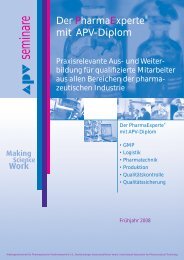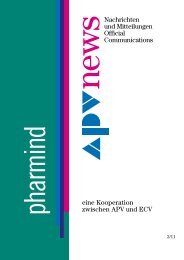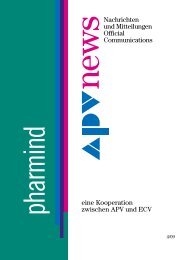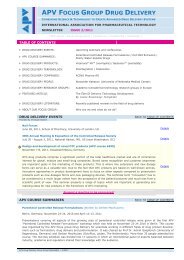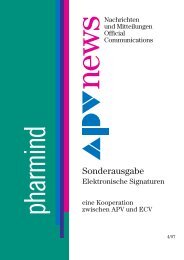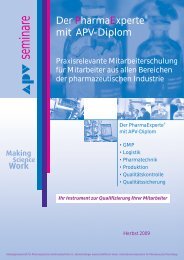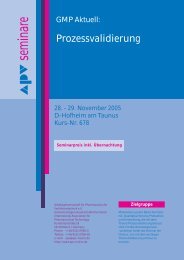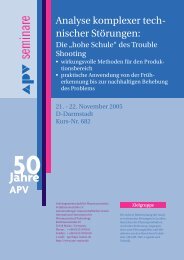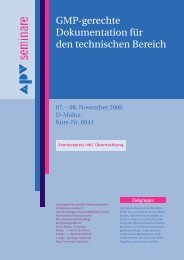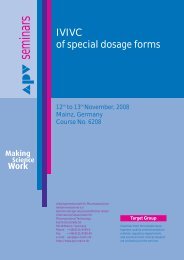APV FOCUS GROUP DRUG DELIVERY
APV FOCUS GROUP DRUG DELIVERY
APV FOCUS GROUP DRUG DELIVERY
You also want an ePaper? Increase the reach of your titles
YUMPU automatically turns print PDFs into web optimized ePapers that Google loves.
a closed, explosion-proof environment, where high-shear kneading processes as well as solvent diffusion contribute to<br />
polymer dissolution. Care needs to be taken not to reduce the molecular weight of the polymer by mechanical force.<br />
After sometimes several days, a clear, isotropic solution of the polymer is achieved.<br />
The main factors controlling content and content<br />
uniformity, besides the solids content in the homogenous<br />
coating mass, is the exactness of the<br />
caliper of the coating substrate, the choice of the<br />
coating process and the precision and selection of<br />
the tooling.<br />
Numerous practical ways of spreading liquid or<br />
semi-solid masses on a web-like substrate are<br />
established. What most of them have in common<br />
is that a gap is formed between two rollers or a<br />
roller and a blade, which not only accomodates<br />
the adhesive, but also the substrate which thus<br />
adds to the caliper variability of the rollers. This is<br />
the reason why in general roll coaters may contribute rhythmic variabilities which follow sinusoidal curves of different<br />
frequency dependent on roller geometry, individual speed or even the caliper variability of the basis foil. For thin layers<br />
of less than 50 micrometres solid thickness, it is for physical reasons already difficult to obtain less than 5 % variability<br />
with roller coaters.<br />
Coating process – the art of reproducible dosing<br />
Independent of the proceeding information, current pharmaceutical coating processes for transdermals include:<br />
• Roll or knife-over roll coating processes, where the gap between a roller and another roll / knife determines<br />
dosage accuracy. The support foil contributes to the imprecision by its own tolerability. There are no severe and<br />
unexpected contributions from machine speed variation.<br />
• Extrusion processes. The coating mass is extruded through a flat die. The precision is mainly dictated by the<br />
constancy of the pumping system as well as the precision of the flat extrusion die over the width. As this<br />
extrusion process is independent of the line speed, a strict ratio needs to maintained and controlled. On the<br />
other hand, there is less dependence on substrate quality. The main application is hot melt extrusion.<br />
Both general process methodologies have their value and are the basis of successful production processes for layers of<br />
about 30 to 100 micrometres with high precision and content uniformity.<br />
Drying processes<br />
Being connected to the dosing equipment, drying usually<br />
attracts less attention but it involves a larger share of the<br />
commercial effort and investment. Obviously, removal of<br />
process solvents is the main target, usually within the limits<br />
given by the ICH residual solvents guideline. Exceeding<br />
certain temperature limits may however lead to losses and<br />
excessive degradation. In real life, process developers need to<br />
compromise between acceptable volatile residues, acceptable<br />
losses and degradation.<br />
The initial phase of drying involves lower temperatures at high<br />
speed; in later phases, diffusion of solvents within the matrix<br />
prevails as the process-time dictating phenomenon. In this<br />
later phase, the temperature is raised continuously based on<br />
experience and experimental trials in order to facilitate<br />
diffusion but avoid formation of bubbles.<br />
Printing processes<br />
In case of volatile ingredients, specifically active ingredients, coating processes cannot ensure that all of the active ingredient<br />
is retained during drying. Application of the active ingredient in liquid form or in a polymeric dilution is the<br />
solution of choice for this problem. This may be both done in the first part of the process by soaking a non-woven substrate<br />
with the active ingredient which is then laminated between two adhesive layers. These layers subsequently get<br />
saturated with active ingredient.<br />
Another possibility is to transfer this technology to a disk-like placing process on the converting line, where printing /<br />
soaking with the active solution can be performed just prior to the individualization of the systems. Also, screen printing<br />
processes have been tried but to our knowledge these have not yet been used to a significant<br />
extent for pharma applications.<br />
<strong>APV</strong> Drug Delivery Focus Group Newsletter – 3/2011 Page 10 of 14



